NRL 2019 pre-season power rankings: The up and the down cross in the night
In the second instalment of the 2019 NRL pre-season power rankings Nick Campton looks at teams on the way up, the way down and some that won’t move at all.
Put the Kookaburra away and hail the comeback of the Steeden, after a long summer the return of rugby league is almost upon us.
When Melbourne host Brisbane next Thursday night the speculation and prediction will be over and all the pre-season tips will be proven to be genius, stupidity or something in-between.
Just about every team has something to like, enough of the good stuff for their fans to start dreaming of finals football but there can be only eight, and then only one who will drink from the keg of glory come October.
These rankings could change by the time the dust settles after Round 1 but as it stands this is where the 16 teams sit in terms of roster strength, potential positional changes and the impact of new recruits and coaches right now.
POWER RANKINGS PART 1: The cellar-dwellers — Bulldogs, Sea Eagles, Eels, Titans

12TH — WESTS TIGERS
2018 finish: 9th
The Tigers have a full deck and depending on the hand they’re dealt they have the chance to end the club’s eight-year finals drought, the longest such dry spell in the league.
Sorting out what to do with their spine will go a long way to determining which way the coin falls at Concord — new captain Moses Mbye is locked in at fullback and Luke Brooks at halfback but five-eighth and hooker are well and truly on the block.
Five-eighth is a two-man shootout between Benji Marshall and Josh Reynolds. Marshall’s return to the Tigers and his resurgence in form was one of the great stories of last season and in Brooks he finally found the halves partner he’d been searching for since Scott Prince left while Reynolds never really got going after a season blighted by injury.
Marshall has the superior kicking game and is more level-headed but Reynolds will be around longer and is the more tenacious. Expect whoever loses out to claim the bench utility role.
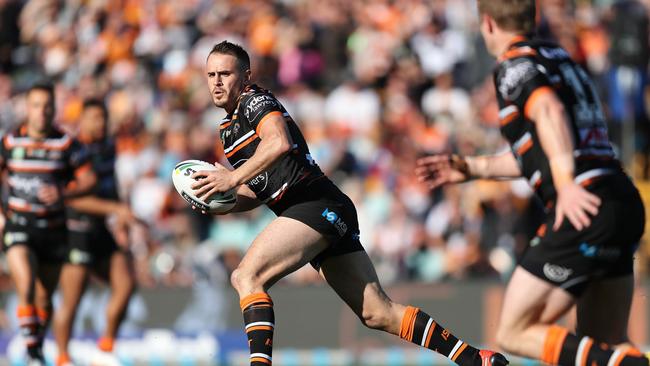
It’s old against young at hooker as Robbie Farah and Jacob Liddle duke it out. Farah also returned to the Tigers last season and while he’s close to the end himself he’s still a wily and capable operator — his kicking game, always one of his great strengths, is still top notch.
Liddle has been forced to endure a few false starts in his career thus far due to numerous shoulder problems but he has the talent to be a representative footballer of the future and his running game is top notch.
Farah is the safer option but Liddle has far more upside.
Outside of these uncertainties, Mbye has a real future as a fullback and Brooks went some way to filling his still considerable potential in the best season of his career last year. Most teams are built from the spine outwards and the Tigers, if they play their cards right, will have a good quartet on their hands.
That shaped as a fun puzzle for Ivan Cleary to solve, especially after the club retained Marshall and Farah on one-year deals on his watch. It capped off a banner year for Cleary, who had spent 18 months turning the Tigers into his own.
He brought Ben Matulino and Russell Packer, two of his guys from way back in the Warriors days, to the club. Another one of Cleary’s favourites, Elijah Taylor, was already there. All the stuff about being on the bus, the improvement of Luke Brooks, the self-belief, it came from Cleary. The entire club — not just the players but the fans as well — didn’t just believe what Cleary put into them, they believed Cleary believed it.
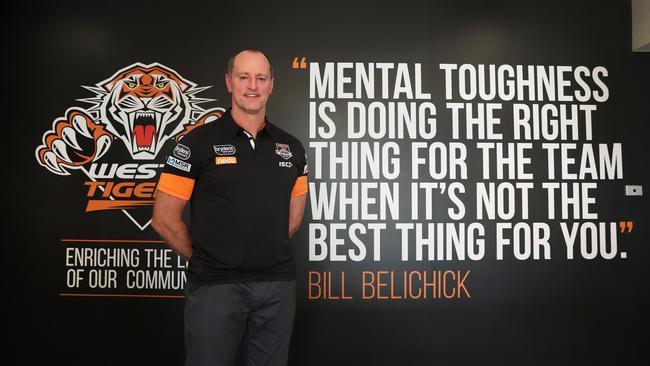
Now he’s gone, Michael Maguire is there and the entire process starts again.
That isn’t to say Maguire is a bad coach or the wrong choice for the Tigers — his record speaks for itself and he was the best option available once the Cleary situation became untenable.
Nor is it a suggestion the players won’t embrace his style — once again, he was the best coach available by some distance and was the right choice for the club.
However, the question must be asked how much change is too much.
Maguire is the club’s third coach since the start of 2017 and the players must once again buy into a new system and a new way of doing things.
It is certain they will do so to the best of their ability but they believed in the old coach and he shot through — can they summon that same belief once more?
The former Souths coach loves a grinder and this team is full of them. They’ll be rough and ready, they’ll run through fire to get the job done but, as they showed at times last year, fanaticism is not enough in the NRL.
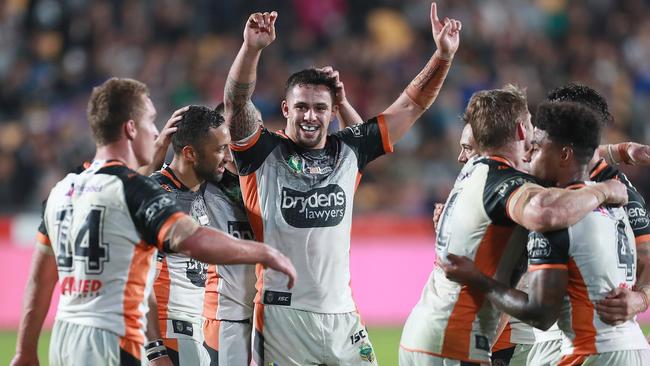
Last year the Tigers wouldn’t just eat a punch to take a punch, they’d wear five to land one. Their greatest moments were gutter wars of frenzied, scrambling defence and the wins, when they came, would make any fan proud. But you know what happens to fighters with iron chins? In the end, without fail, they crack. And once they crack there’s nothing that can put them back together again. The Tigers conceded more than 30 points just twice last year and one of them was in a Round 26 game against the Rabbitohs they needed to win to keep their faint finals hopes alive.
Nobody would say they packed it in, but in the end living every tackle in every minute of every game is too much. From the looks of things, unless the points begin to flow, the Tigers will have to do it all again — armoured only in belief they’ll have to march forward, chin in the air, waiting for the punches to land.
Best XVII: 1. Moses Mbye, 2. Corey Thompson, 3. Robert Jennings, 4. Esan Marsters, 5. David Nofoaluma, 6. Josh Reynolds, 7. Luke Brooks, 8. Russell Packer, 9. Robbie Farah, 10. Ben Matulino, 11. Chris Lawrence, 12. Ryan Matterson, 13. Elijah Taylor. Interchange: 14. Benji Marshall, 15. Alex Twal, 16. Matt Eisenhuth, 17. Michael Chee-Kam
Stat of note: The Tigers have finished ninth (five times) more often than they’ve made the finals (three times)
The big question: Where do the points come from?
As improved as the Tigers were last season their Achilles heel was their attack. In 24 games they only passed 24 points twice — against wooden spooners Parramatta and another straggler in Manly. A lot of the time this wasn’t a problem, after all they did manage two wins over the Storm and one each over the Roosters and Dragons by a combined total of nine points.
But scoring one try a week and winning just isn’t sustainable over the course of an entire season.
From Round 11 to Round 18 they did not score more than four tries in a match once and their 2-5 run over that stretch put them on the outside of the finals looking in.
Brooks enjoyed the most consistent and best season of his first grade career but at times he played something of a lone hand in the creative department.
A full off-season training with whatever spine Maguire chooses should go some way to alleviating the problem — the Tigers attack did improve almost immediately after Farah and Mbye joined the club.
Breakout player: Alex Twal
Twal was a standout prop in the juniors and since he joined the Tigers midway through 2017 from Parramatta he’s put in some very solid performances off the bench. The hardworking 22-year old has an excellent tackling technique and a top shelf motor — it may be a couple of years before we truly see the best of him as props develop later than other players but he’s a good’un.
Once Ben Matulino and Russell Packer leave, Twal shapes as the natural forward leader for the Tigers. More game time will come his way in 2019 and he’s got the ability to make the most of it.
NRL FANS SURVEY: Take our short survey to make your voice heard on the great game of rugby league.
11TH — CANBERRA RAIDERS
2018 finish: 10th
Ricky Stuart has never given anything less than his best to Canberra and the best of Canberra has, invariably, revolved around Ricky Stuart.
The Raiders have made the preliminary final eight times and Stuart was there for seven of them, six as a player and one as a coach. That one as a coach was in 2016, the most glorious Canberra season since the last premiership in 1994.
It was the club’s first chance at playing for a grand final spot since 1997, which at the time was the longest drought of any team in the league.
After years of false starts, stirring late-season runs that fell short of true contention and having their eyes picked out in the form of young stars leaving for richer pastures, Stuart had built the Raiders into a glorious attacking machine that resembled the teams he himself played in — the 2016 Raiders scored 688 points, the most of any team in club history, 200 more than the 1989 premiership team, 150 more than the 1990 premiership team and 11 more than the 1994 champions, the best team in club history, who were the second most prolific attacking team in first grade history at the time.
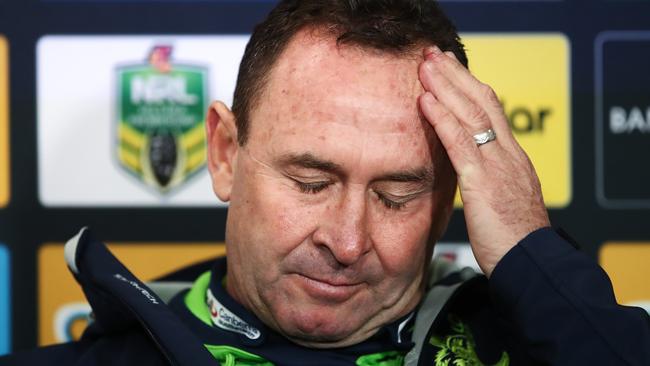
They were a wonderful team to watch and they should have been proud of their efforts. Losing a preliminary final to Melbourne on the road by a mere two points is no disgrace and if things had bounced another way (most notably if Josh Hodgson hadn’t been injured two weeks before against Cronulla) Canberra could have gone all the way.
But that was three years ago now, professional sport is a “what have you done for me lately” type business and what the Raiders have done lately is be close enough but not quite good enough. It’s been that way for long enough now that the heat is well and truly on Stuart.
This season will be Stuart’s sixth as Canberra coach and after the club finished 15th in 2014 things have been remarkably consistent, finishing 10th, 2nd, 10th and 10th.
The story has remained the same — the Raiders are still a gifted attacking unit, one of the best in the competition. They scored 563 points in 2018, behind only South Sydney, and were third in points scored in 2017 but the Achilles heels is, and always have been, a maddening inability to close out tight matches that now borders on a psychological disorder.
Since the start of 2015 the Raiders have lost 28 matches by less than 10 points. Twenty-five of those matches were by six points or less. Twenty-two of those matches were by less than four points.
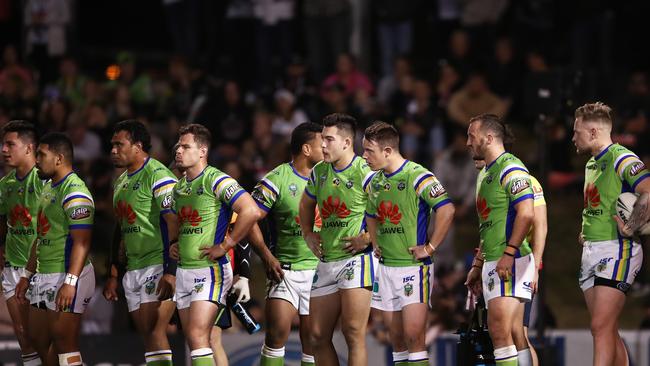
They have lost close games in every way you can imagine. They have set up big leads and been run down and had valiant comebacks fall just short.
Against the Cowboys in 2017 they lost when a Johnathan Thurston field goal attempt in golden point extra-time hit the crossbar and sat in the in-goal for Gavin Cooper to dive on it and score. Later that year they conceded two tries in the final 90 seconds to lose to Penrith on the buzzer in Bathurst.
They had the bizarre loss to Cronulla last season, when a flag was raised by the touch judge but not heeded, and came only months after they lost their opening three games by a combined total of five points.
There were the two golden-point losses to Manly in 2017, the last-second field goal against the Cowboys in 2015, the 2018 Tigers loss that all but ended their finals hopes.
Even 2016 was not exempt from such horrors — ask any Raiders fan about the Jack Wighton game against the Dragons. They’ll either go white as a ghost or start swearing loudly because they support rugby league’s truest maniacs.
What makes these losses all the more painful is there is no single factor that has contributed to them.
Some of them, but not all, came from poor decision-making from the halves. Some, but not all, came down to weak defence around the ruck.
Some, but not all, came from brain explosions from players that should know better.
Some, but not all, came from refereeing decisions and some, but not all, came down to horrifically bad luck.
That makes it hard to fix. It’s not as simple as one player doing their job better or some magic inclusion that’ll turn the Raiders into master of the final five minutes (although a more robust defence would go a long way towards solving the problem).
Stuart and his Raiders must deal with this rugby league hydra while also navigating a new halves combination, a new fullback, a remodelled forward pack and losing one of their best players, Jordan Rapana, for up to half the season.
It’s a lot to deal with, and if Canberra miss the finals for the sixth time in seven years even Stuart, off contract at the end of 2020, won’t be able to escape the heat.
Raiders fans can explain away many of the close losses, but at some point you are what your record says you are.
The big question: What will Jack Wighton do at five-eighth?
In the final stages of the 2014 season, Stuart’s first with Canberra, he switched Jack Wighton to fullback. It marked the first real period of stability for the Orange product — since his debut two years before he’d switched between wing and centre while also enduring a forgettable stint at five-eighth to begin the season, an experiment that was ended after nine matches.
The four years since have been a wild ride for Wighton. There were times when his physicality and athleticism made him seem like a fullback of real potential. There were times when his hands deserted him completely and he collapsed under a mountain of errors. There were times when he was one of Canberra’s most important attacking players in a structural sense and there were times he made choices that were quite literally too baffling for words.
In good times and bad, Stuart stood by his decision to play Wighton at fullback, always.
He once said he would not trade Wighton for any fullback in the NRL, and last season the 26-year-old seemed to have turned a corner. Before a lengthy suspension ended his season he was Canberra’s best player and on track for career highs in try assists and a career low in errors. The waiting was seemingly about to pay off and Wighton, after four years, was becoming an out-and-out fullback rather than a talented footballer who played fullback.
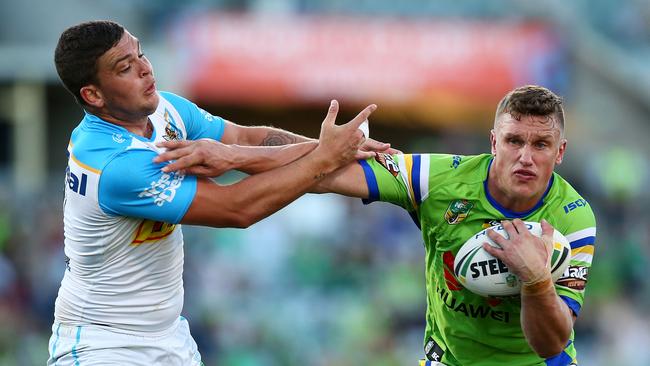
Now, after four years, Stuart is trying Wighton in the halves again. The main questions here are threefold. The first, and most obvious, is how Wighton will adapt to the new position. He is likely to operate mainly on the left side of the field, where he did his best work as a fullback and forged a strong combination with Jarrod Croker. Wighton’s numbers from his first stint at five-eighth are not strong — in nine matches he managed three try assists, one line break assist, no line breaks, 13 errors and 2.1 missed tackles per game.
Wighton is undoubtedly a better footballer now than in 2014 but the form doesn’t inspire confidence
It also means Canberra will rely heavily on Aidan Sezer, who must once again be part of an unfamiliar spine combination. In his fourth season with Canberra the unfairly maligned Sezer will have to take a greater playmaking responsibility given Wighton’s inexperience.
To top it all off, the Raiders are now on a fullback search as well.
Michael Oldfield and new man Charnze Nicoll-Klokstad are seemingly the main contenders with specialist Brad Abbey puzzlingly a fair way back as third choice.
Neither Oldfield nor Nicoll-Klokstad has started a first grade match at fullback and while they are both talented wingers it is difficult to see either man as a long-term option.
Moving Rapana away from his combination with Joey Leilua doesn’t make sense, and Serbian gorilla Nick Cotric is more than capable as a runner and kick returner but his passing game isn’t there yet
Abbey showed glimpses of real ability in his brief time at fullback last season but seems out of favour.
Wighton’s move impacts not only himself, but so much of the team around him. It is the hinge on which Canberra’s season will swing.
Best XVII: 1. Jack Wighton, 2. Nick Cotric, 3. Jarrod Croker, 4. Joey Leilua, 5. Jordan Rapana, 6. Aidan Sezer, 7. Sam Williams, 8. Josh Papalii, 9. Josh Hodgson, 10. Dunamis Lui, 11. Elliott Whitehead, 12. Joseph Tapine, 13. John Bateman. Interchange: 14. Siliva Havili, 15. Corey Horsburgh, 16. Emre Guler, 17. Sia Soliola
Stat of note: Canberra have made the finals once in the last six years
Breakout player: Corey Horsburgh and Emre Guler are two talented young props who should see plenty of action from the bench at stages through the season but Canberra need John Bateman to stand out.
The Englishman was a Man of Steel candidate last year for Wigan and is emblematic of the club’s move away from giant forwards to a more mobile pack. If he lines up in the middle as expected, Bateman’s footwork, offloads and defensive aggression could be just what the doctor ordered for the Green Machine.
10TH — NEWCASTLE KNIGHTS
2018 finish: 11th
Under Nathan Brown Newcastle have lost 56 matches, drawn one and won 15. They claimed three straight wooden spoons and became the first team in almost a quarter of a century to go through a season with only one win. They have well and truly had their guts pulled out while they were still alive and were forced to crawl through 500-yards of shit-smelling foulness the likes of which we can’t imagine.
All that must be over now. For the first time in a long time Newcastle has depth in key positions, competition for spots and that most crushing of factors, expectation. No longer are the Knights the loveable losers who scraped together three wins a year and celebrated each of them like a grand final.
Given the squad at their disposal, the Knights should be aiming for a finals berth. They have the talent across the board, a strong home-ground advantage and a fan base that deserves a bit of joy given how they stuck solid through the truly awful years of the post-Wayne Bennett era.
The thing that should give Knights fans the most hope is their excellent forward pack because it’s good enough to carry them through just about anything. David Klemmer will rightly get much of the plaudits but James Gavet is an astute purchase — he’s been one of New Zealand’s best forwards over the last 18 months and would have been a smart addition for any team in the league.

With Tim Glasby, Daniel Saifiti, Mitchell Barnett and possibly Aidan Guerra along for the ride the Knights have a deep and experienced middle which should be able to set the platform week to week.
But all of that won’t count for much if Kalyn Ponga’s highly scrutinised and risky move to five-eighth doesn’t pay off.
Much and more has been written about Ponga’s exemplary first season with the Knights — it is no exaggeration to say he is their most popular player since Andrew Johns and the Queenslander can already be counted among the game’s elite.
It is therefore a little puzzling as to why he’s been switched to five-eighth in the first place. Ponga’s capability in the position is not in question — he makes good decisions with ball in hand as a second or third receiver, his speed and footwork speaks for itself and he’s capable of adapting to the defensive requirements.
But Ponga did show last season how good he is as a fullback and changing that feels a bit like weakening a strength to strengthen a weakness.

Connor Watson may well be more capable as a fullback but with Mason Lino joining the club there was no clear need to switch Ponga. A Lino-Pearce halves combination would give Newcastle an extra kicking game and a fine goalkicker while the best of Ponga’s ability with the boot has been limited to the short, attacking variety.
Ponga may well make a good fist of five-eighth, but it is a gamble and it will take time. Making proclamations about Ponga’s future based on some trial form and 50 minutes in the All Stars clash is premature but regardless of what kind of five-eighth Ponga becomes it won’t happen right away.
Do the Knights have the patience to wait out the growing pains, especially given the renewed expectations? Nobody wanted to kick a wooden spoon team when they were down, but that luxury is now gone. Ponga is one of the biggest stars in the game — if he struggles early, and odds say he will, the knives will come out.
Will Brown hold fast or give into the pressure which is all but certain to come? Given Ponga is the one who approached Brown about making the switch in the first place it’s a big call in more than one respect.
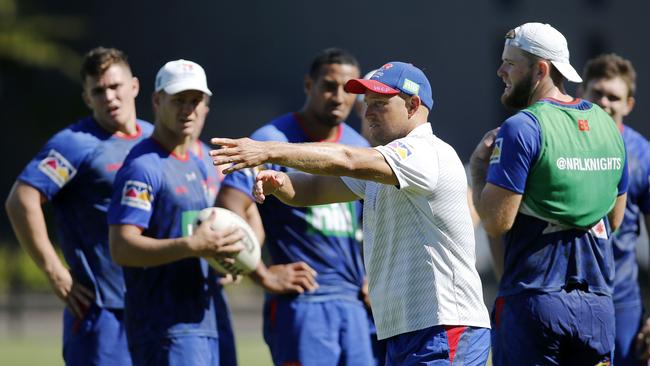
And while the Knights had success last season relative to the years prior, there is still much to do. They still conceded 607 points, the second most in the league. After their early run they went 4-12 to end the season. Ramien is a great buy but beyond him the backline is short of out and out stars.
The Knights are right to dream big after the misery they’ve been through, but there are still steps that need to be taken and cannot be skipped. Try to fly too high, too early and it’ll be the fall that kills you.
Best XVII: 1. Kalyn Ponga, 2. Edrick Lee, 3. Tautau Moga, 4. Jesse Ramien, 5. Shaun Kenny-Dowall, 6. Mason Lino, 7. Mitchell Pearce, 8. James Gavet, 9. Kurt Mann, 10. David Klemmer, 11. Mitch Barnett, 12. Lachlan Fitzgibbon, 13. Tim Glasby. Interchange: 14. Connor Watson, 15. Daniel Saifiti, 16. Herman Ese’ese, 17. Aidan Guerra
Stat of note: Thirty-nine players have made their club debut for Newcastle since the start of 2016
The big question: Can Nathan Brown get the horses running?
It’s hard to paint a full picture of Brown’s second stint as an NRL coach. He was saddled with a bad roster, a terrible salary cap situation and an edict to burn it all down and start again.
It’s been a long road, but now Brown has a team to make the finals and what’s interesting is the way it’s been built. The Hunter region is one of the most fertile junior grounds in the country but if their top team looks as expected just three of the 17 made their NRL debut for the Knights.
There’s nothing wrong with building a team through the transfer market. Newcastle have done very well to land Ponga, Klemmer and Pearce, three signings which can change the trajectory of the club. The Knights also took a chance on Herman Ese’ese, handing out a big money contract to a player who’d had one full season in the NRL, with limited minutes at that, and the former Bronoo was their best forward in 2018.
Of the scores of players who made their NRL debut for the Knights since Brown took over in 2015 only the Saifiti twins, Lachlan Fitzgibbon and possibly Danny Levi would play a major role in a fully fit side. This is not a criticism of the method of Newcastle’s rebuild, but it is a curious development.
Regardless, Brown now has a finals-calibre team on his hands. What he does with it is another matter entirely.
Breakout player: It’s cheating to count Jesse Ramien as a breakout player given he played 20 games for Cronulla last season but he’s an excellent purchase for the Knights. Ramien gives the club strike, speed and power out wide and proved himself the best centre at the Sharks last season. It is not presumptuous to say he can enter the representative conversation in the next year or two.
9TH — NEW ZEALAND WARRIORS
2018 finish: 8th
In the immediate aftermath of Shaun Johnson’s move to the Warriors many myths surrounding the Kiwi Test star, his place in the league and what kind of career he’s had to this point sprang forth. Let me tell you sports fans, many of the takes burned with the heat of hell itself.
Johnson’s critics said he never stood up in big games, which isn’t true because he’s won on big stages with New Zealand plenty of times — more than once he was the best player on the field in Test wins over Australia.
They said he was overpaid and wasn’t worth the same amount of money as Johnathan Thurston, Cooper Cronk or Cameron Smith, which is the same as saying he’s not as good as three possible future Immortals. When they find a player who is make sure we all know about it.
They said he was to blame for the Warriors’ prolonged finals drought as if Johnson wasn’t one of the shining lights during a period of great upheaval and poor roster management when the club went through four head coaches in six years.
They point to his disappointing performance last season, as if 18 try assists, seven line breaks, 14 line break assists and his lowest error count since 2012 is a dud run.

They hold up the loss to the Panthers, when Johnson had an absolute barney, as proof that he’s no good, ignoring the injury to Roger Tuivasa-Sheck and the fact that just about the entire team struggled — making the finals were their mountain and they hit the wall.
Here’s what is true about Johnson — he is one of the best halfbacks in the competition, an extremely gifted player who can lead a team to a premiership with the right team around him.
The Warriors had that team and they can hide behind the idea that nobody is bigger than the team or they’re building a new culture but the fact of the matter is simple: with their best 17 available and Shaun Johnson at halfback the Warriors are a premiership caliber side.
They finished one win off first last season and that was with Johnson missing six matches and their best spine (Roger Tuivasa-Sheck, Blake Green, Johnson and Issac Luke) playing just 14 games together. Of those 14 games the Warriors won nine of them and avenged two of the losses.
The Warriors spent every single week of last season in the top eight despite various, small injuries ensuring every player on the roster missed at least two games. This is a team that, with Johnson, was locked and loaded and ready to make a charge for the title.
Instead, the Warriors have missed the forest for the trees. Why do teams play this game? Rugby league is about so many wonderful things but winning is one of them, maybe the biggest one of all. In the words of Bill Parcells, this is why you lift all them weights.
The Warriors may have blown their title chance before it really began.

The promise the club showed last season was not the flashy stuff of the past, where they dazzled with their skill and potential but weren’t worth all that much at the end of the day. Stephen Kearney unlocked something within the team and within himself that turned them into hard-nosed competitors while retaining the attacking football that make them so alluring for tipsters.
The Adam Blair signing, which was derided at the time, turned out to be a great success as the veteran forward produced his best season in first grade since he was at Melbourne. He gave the Warriors a toughness and an intensity they’d lacked since the Ivan Cleary years and that showed up defensively where the Warriors conceded the fifth least points in the competition.
Good teams defend well and win on the road and the Warriors did both, going 8-4 away from the confines of Mt Smart Stadium. That’s the best road record in the team’s history and level with the Roosters, Storm and Rabbitohs as the best in the league.
Tohu Harris is one of the best back-rowers in the league and Isaiah Papali’i is the most underrated forward prospect going around. The rejuvenation machine worked on Issac Luke and he became the team’s beating heart. Unheralded forwards like Bunty Afoa, Sam Lisone and Agnatius Paasi became important contributors every week. Jazz Tevaga gave up 20kgs to his opponents every week but played with the tenacity of a bad-tempered rottweiler on a chain in a small yard.
Solomone Kata was one of the most improved players in the competition, second only to Ken Maumalo as the big winger went from borderline unplayable due to his buffoonish errors to a metre-eating leviathan and a Test starter for New Zealand. David Fusitu’a is an assassin of a try-scorer and once he gets a shot at the line you can forget about the rest.
Blake Green was the halves partner Johnson has been waiting for his entire career. Tuivasa-Sheck won the damn Dally M Medal. They did the circle breathing thing after tries and it was awesome.
This was it. This was the team and this was the time. All the pain and disappointment was over, this was a team you could really believe in, who had taken the lumps and come out stronger. Going from a win off the minor premiership to a premiership is very possible. It was close enough to reach out and touch.
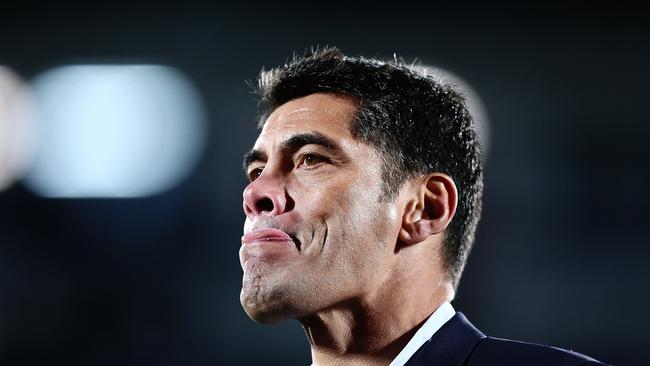
Instead, they will now be pitched back into the mid-table uncertainty whence they came.
If Mason Lino, who impressed during his relief of Johnson last year, was still around then the decision is more understandable but he was signed by the Knights two months before Johnson was released.
The process of Johnson’s departure without a clear replacement must be examined, especially given the Warriors’ premiership window was beginning to open. Whoever had a hand in the decision, be it Kearney or other forces at the club, will bear the weight of consequence.
The Warriors freed up cap space by losing Johnson but is there anyone they could realistically spend it on who would be a proper replacement?
It could take years before the Warriors land another halfback of Johnson’s calibre, through free agency or junior development. They had one of the best halfbacks in the league and they wasted him until they gave him the boot.
Given the team Kearney has built the Warriors may still make the finals. Leeson Ah Mau is an experienced and battle-tested veteran who is coming off the best year of his career and recruiting him was a smart move. The forward pack lacks a true metre-eater but that’s offset by the truly terrifying yardage capabilities of the back five — although Kata and Peta Hiku switching sides is a tough one to figure out.
A playoff berth should be the goal, but the Warriors could have aimed higher had they managed to hold on to a player that never wanted to leave. They call them premiership windows because they can be shut and the Warriors may have closed it themselves.
Best XVII: 1. Roger Tuivasa-Sheck, 2. David Fusitu’a, 3. Peta Hiku, 4. Solomone Kata, 5. Ken Maumalo, 6. Blake Green, 7. Adam Keighran, 8. Leeson Ah Mau, 9. Issac Luke, 10. Agnatius Paasi, 11. Isaiah Papali’i, 12. Tohu Harris, 13. Adam Blair. Interchange: 14. Jazz Tevaga, 15. Sam Lisone, 16. Bunty Afoa, 17. Nathaniel Roache
Stat of note: The Warriors have won two finals games this decade.
The big question: Can Adam Keighran work?
Adam Keighran, Johnson’s expected replacement, played some fine football in the lower grades, but not even the majority of that was at halfback. He won selection in the NSW Cup team of the year last season as a centre. Expecting him to rise to the occasion in his first year of first grade is an extremely tall order.
Keighran’s strengths are his goalkicking and running game and while he played reasonably well in the trial victory over the Tigers right now he doesn’t have what you’d call gamebreaking capabilities.
It would seem that Keighran’s ceiling for this season is a game manager in the style of a Lachlan Lewis or, ideally, Blake Green but given the Warriors already have the most Blake Green type player in the competition in the form of, y’know, Blake Green it’s difficult to see just how Keighran fits in.
Breakout player: Isaiah Papali’i
Papali’i is too established to truly be a breakout player but more people need to notice him — if he was playing on the other side of the Tasman there would be no debate about his placed as one of the best up and coming backrowers in the league.
Mobile, robust and blessed with great ball skills, Papali’i had his first full season in the NRL last year and thrived. The former junior rugby union standout is the kind of player who can play in the big league for a decade and he gives the Warriors a back-row threat on either edge when he’s paired with Tohu Harris.
Still only 20, Papali’i made his Test debut for Samoa and New Zealand last season and there are few limits to what he can achieve. He’s one of the top prospects in the sport.



